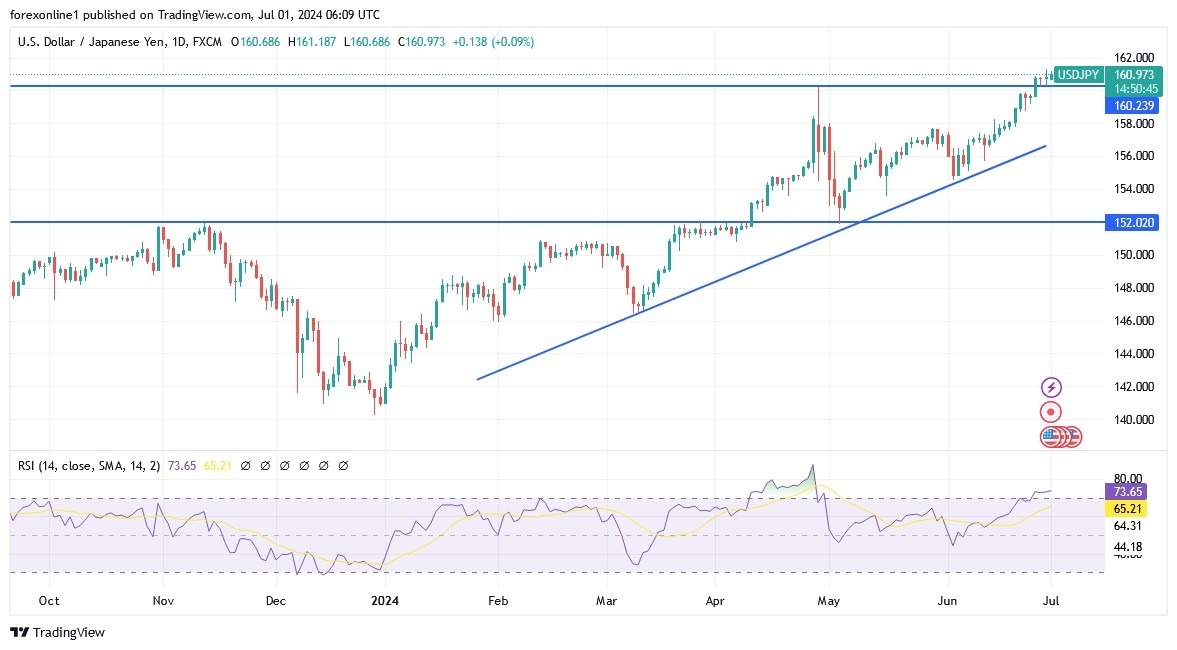- The Japanese yen fell to around 161 yen per US dollar, breaking through this level for the first time since 1986, as the Ministry of Finance appointed Atsushi Mimura as Japan’s top currency diplomat, replacing Masato Kanda.
- The appointment comes as the sharp decline in the value of the Japanese yen has put continued pressure on Japanese authorities to defend their currency, but they have so far appeared to have declined to intervene in foreign exchange markets after doing so in late April.

Earlier in the week, Finance Minister Shunichi Suzuki warned that sudden unilateral moves in the yen are undesirable and that authorities will take appropriate action if necessary.
According to Forex trading, the Japanese yen has lost more than 2% against the US dollar so far in June, continuing its year-to-date decline to around 14% as the Bank of Japan took a more dovish approach to normalizing monetary policy than markets had expected. Meanwhile, Japanese retail sales and industrial production data came in stronger than expected in May, while inflation in Tokyo accelerated in June.
On the economic calendar front, the US headline inflation reading is helping advocates of a September interest rate cut. The Federal Reserve could consider cutting US interest rates in September, according to analysts reacting to the headline inflation reading that fell to a three-year low. According to an official announcement, the US core personal consumption expenditures index rose by just 0.083% on a monthly basis in May, the BLS said, down from an upwardly revised 0.3% in April. Moreover, the figure was in line with consensus (0.1%) and helped push the annual rate down to 2.6% from 2.8%, the lowest in three years.
Because the figure was in line with expectations, there was little reaction in bond and currency markets. However, the data will help build the case for a Federal Reserve rate cut in September, some analysts say.
The PCE is a measure of inflation that is particularly important to consumers and is therefore closely watched by the Fed. “Fed officials, who are responsible for managing inflation, prioritize the PCE over the CPI when setting the effective federal funds rate,” says Nigel Green, CEO of DeVere Group.
Further refinement of the figures shows the “super” measure — basic services excluding housing rents — slowing to 0.1% on a monthly basis, the slowest since August. Also, the data set includes figures showing consumption slowing due to higher interest rates. Real consumption rose 0.3% month-on-month in May, and second-quarter consumption growth now trails at just 1.6%.
Top Forex Brokers
Capital Economics estimates GDP growth has now slowed to 1.8% in the second quarter, “capping off a weak first half of the year. Like Biden, consumers appear to be stumbling at the wrong time, finally succumbing to the pressure of higher interest rates.” Added, “That’s exactly what the Fed wants to see, and I think it’s clear now when you look at the data broadly that the inflation trajectory is firmly down. However, for a September cut, we’re really going to need to see a little bit more.”
Meanwhile, Kyle Chapman, FX analyst at Ballinger Group says: “This is the kind of number that’s going to be repeated over the next two or three prints to convince the Fed that 2% is within their reach,”.
However, Green of DeVere Group says the Fed will want to see more months of positive data before cutting rates. “Our previous forecast that the Fed will not cut rates until 2025 now appears to be gaining traction among a growing number of policymakers as well.”
“We are still not at the point where it is appropriate to cut rates,” Fed policymaker Michelle Bowman said last week. “Given the risks and uncertainties surrounding my economic outlook, I will remain cautious in my approach to considering future changes in the policy stance.” Also, she revealed that she is one of several Fed policymakers who do not see any cuts this year, making her one of four Fed policymakers who believe US interest rates will remain unchanged.
USD/JPY Technical analysis and Expectations Today
Last Thursday’s rally pushed the USD/JPY pair just above its 100-hour moving average. However, the pair still appears to have plenty of room to run before reaching overbought conditions on the 14-hour RSI. In the near term, based on the hourly chart, the USD/JPY pair is trading within an ascending channel formation. However, the 14-hour RSI still has room to run before reaching overbought conditions. Therefore, bulls will look to extend the current rally towards 161.29 or higher to the 161.88 resistance.
On the other hand, bears will look to pounce on pullbacks around 160.24 or lower at the 159.62 support. In the long term, based on the daily chart, USD/JPY continues to trade within an ascending channel. Also, the 14-day RSI appears to support a long-term bullish bias after entering overbought conditions. Therefore, bulls will target long-term gains around 162.57 or higher at the 164.39 resistance. On the other hand, bears will look to pounce on pullbacks around 158.85 or lower at 156.91.
Begin trading USD/JPY with our analysis and forecasts. Get our top 100 best recommended brokers.

